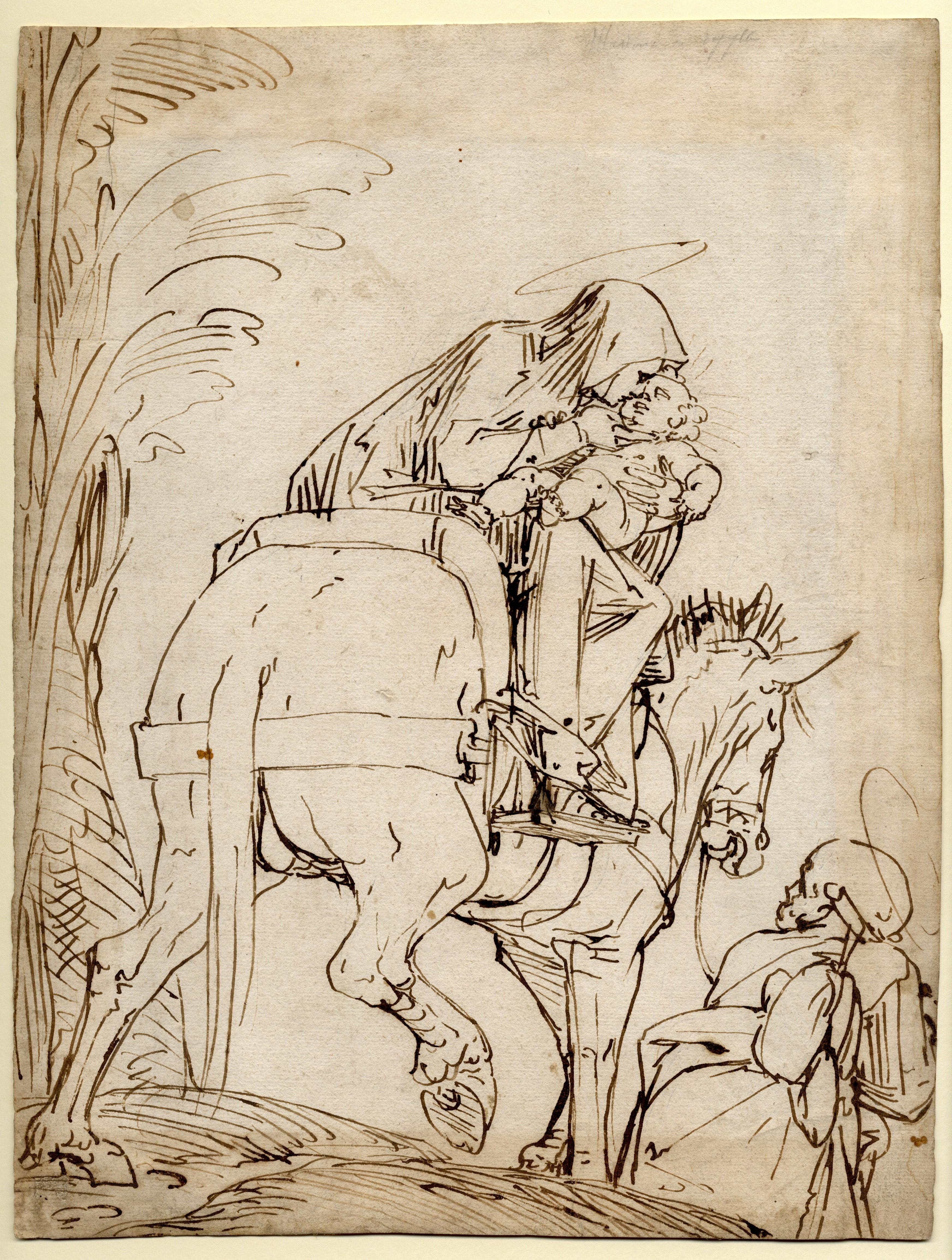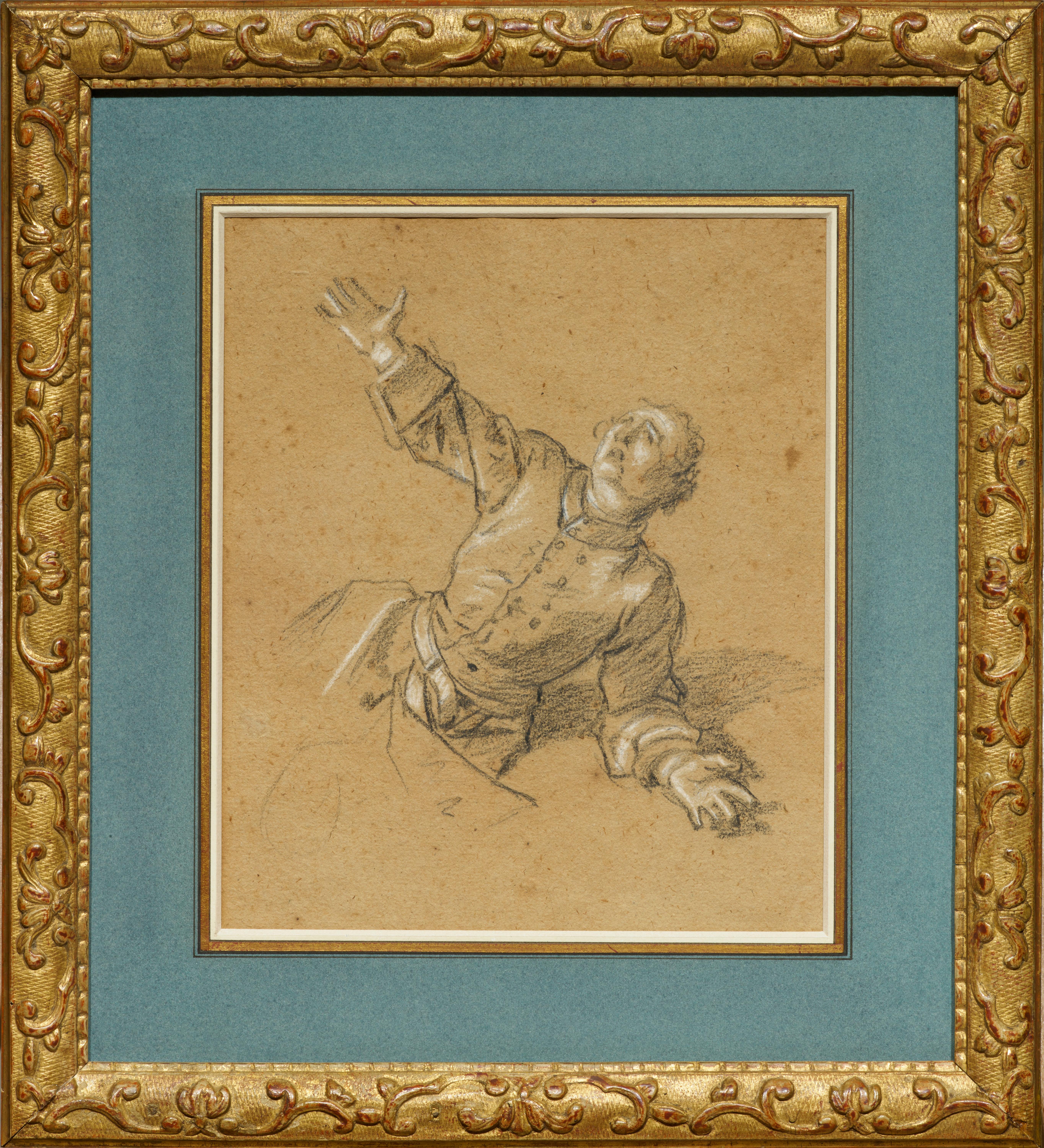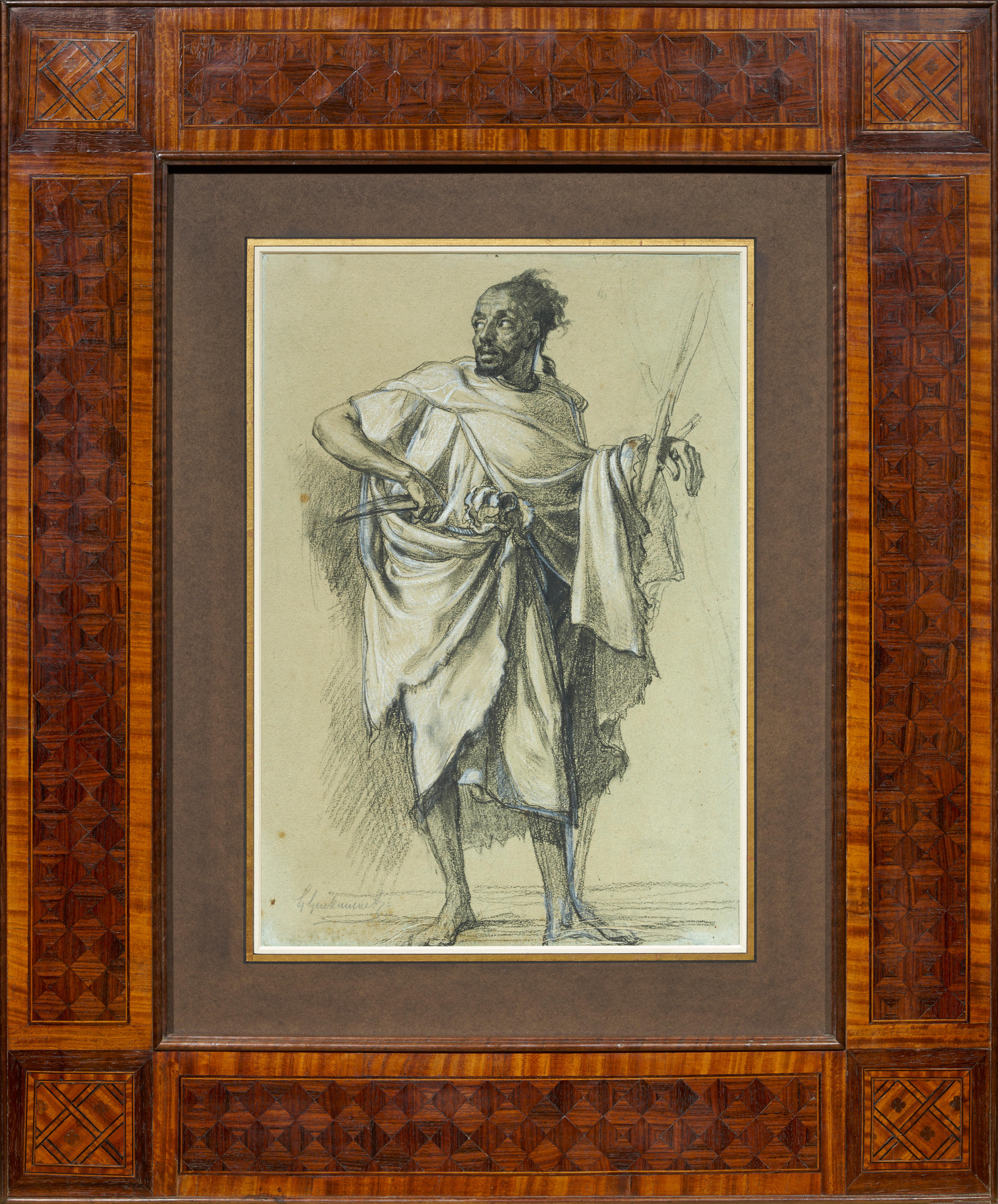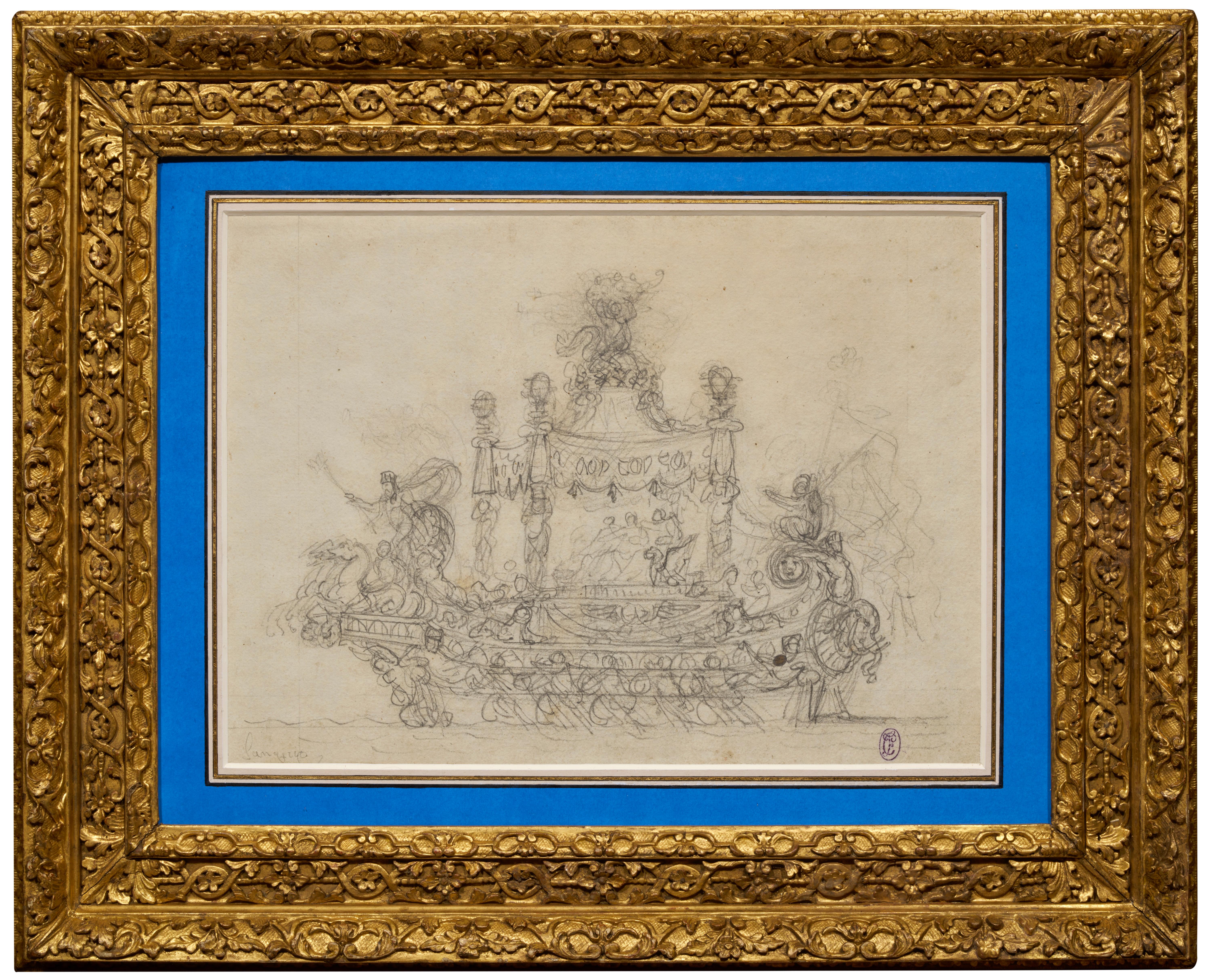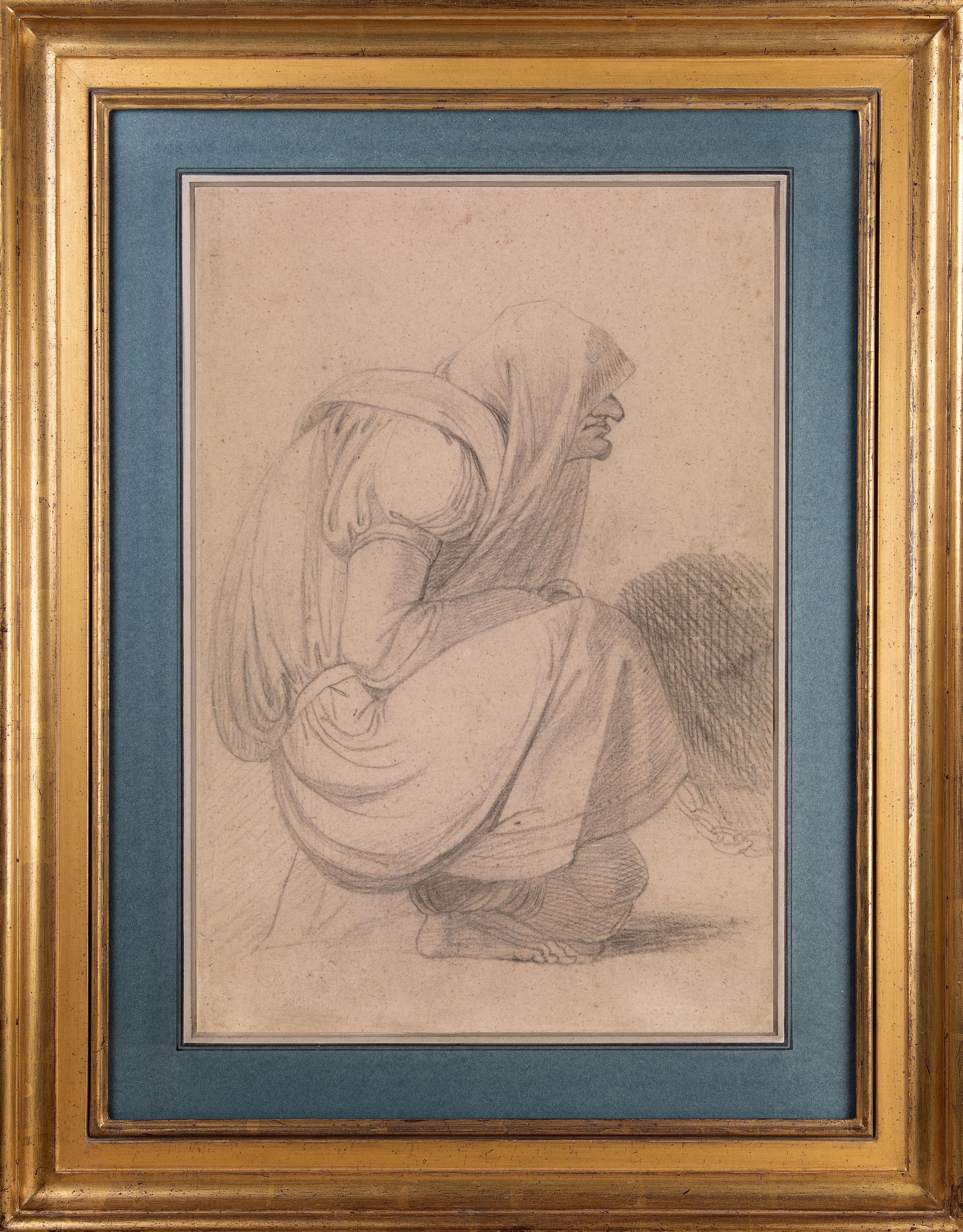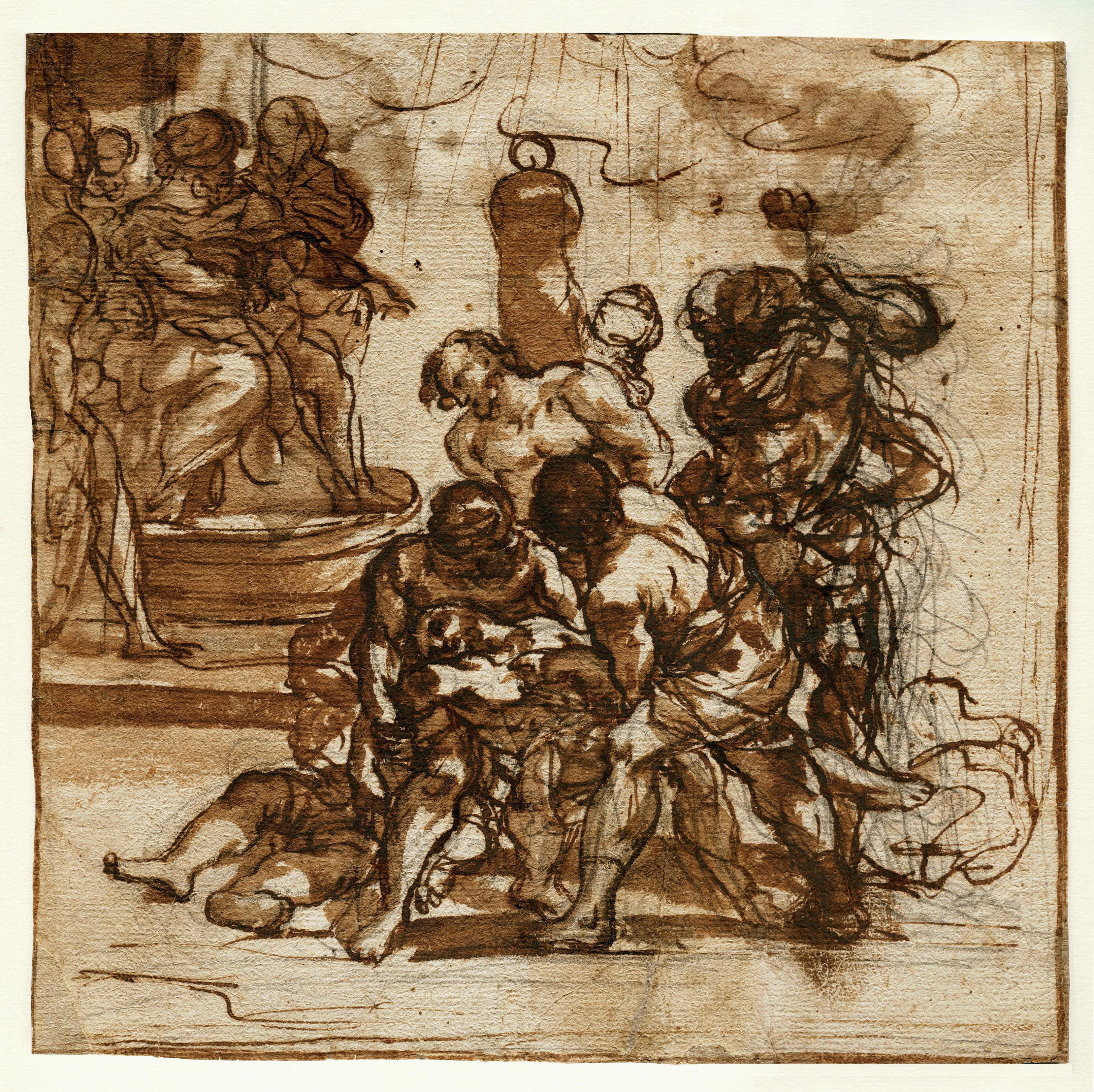Items Similar to Italian 18th Century red chalk study of a seated man by Zuccarelli
Want more images or videos?
Request additional images or videos from the seller
Francesco Zuccarelli RAItalian 18th Century red chalk study of a seated man by Zuccarelli
About the Item
Francesco Zuccarelli RA (Italian, 1702-1788)
Study of a seated man
Red chalk
11.1/8 x 7.5/8 in. (28.3 x 19.3 cm.)
Provenance; Colnaghi & Co, London
Francesco Zuccarelli was born in Pitigliano, Italy in 1702. At a very young age he moved to Rome, where he studied under several painters and eventually specialized in landscape. He then spent time in Florence before settling in Venice in the 1730s, where he became celebrated for his pastoral scenes. There Zuccarelli enjoyed the patronage of numerous Englishmen on the Grand Tour. The British consul Joseph Smith was also an important patron for Zuccarelli during this period, as he was for another Venetian painter, Canaletto. Zuccarelli moved to London in 1752, following in the footsteps of Canaletto (who was in England between 1746 and 1755). Smith, who helped Canaletto sell his paintings to English clients, may have influenced Zuccarelli in this decision to move to a country where there was already a strong demand for the artist’s work. The artist Richard Wilson, whom Zuccarelli met in Venice in 1751, may also have recommended the move. Zuccarelli returned to Italy in the early 1760s, but was back in London by 1765, exhibiting that year at the Free Society. He was one of twenty-two artists who petitioned King George III to found a new academy in 1768, and became a Founding Member when the Royal Academy of Arts was established shortly afterwards. The King also commissioned paintings from him including The Finding of Moses (1768; Royal Collection). In Johan Zoffany’s group portrait The Academicians of the Royal Academy (1771-2; Royal Collection) Zuccarelli is placed in a prominent position directing the Keeper (Director) of the RA Schools, George Michael Moser, who sets the life model. Zuccarelli last exhibited at the Royal Academy in 1773 and returned to Italy the following year, settling in Florence where he died in 1788.
- Creator:Francesco Zuccarelli RA (1702 - 1788, Italian)
- Dimensions:Height: 11.13 in (28.28 cm)Width: 7.63 in (19.39 cm)Depth: 1 in (2.54 cm)
- Medium:
- Movement & Style:
- Period:
- Condition:Foxing and surface dirt, behind glass, float mounted with gilt and washlines, further mounted and in a gilt composite frame with chips, minor losses and abrasions.
- Gallery Location:Petworth, GB
- Reference Number:1stDibs: LU540312131232
About the Seller
4.9
Platinum Seller
These expertly vetted sellers are 1stDibs' most experienced sellers and are rated highest by our customers.
Established in 2010
1stDibs seller since 2017
228 sales on 1stDibs
Typical response time: 3 hours
- ShippingRetrieving quote...Ships From: Petworth, United Kingdom
- Return PolicyA return for this item may be initiated within 10 days of delivery.
More From This SellerView All
- Pair of 18th Century watercolour drawings by Old Master Carle VernetBy Carle Vernet (Antoine Charles Horace Vernet)Located in Petworth, West SussexCarle Vernet (French, 1758 – 1836) ‘La Marchande de Coco’; and ‘La Tour de Babbe d’un Charbonnier’ Ink, watercolour on paper Both signed C Vernet and Carle Vernet (lower left and lower right respectively) 12.1/4 x 9 in. (31 x 22.8 cm.) A pair Vernet was born in Bordeaux. At the age of five, he showed an extraordinary passion for drawing horses, but went through the regular academical course as a pupil of his father and of Nicolas-Bernard Lépicié. Strangely, after winning the grand prix (1782), he seemed to lose interest in the profession, and his father had to recall him back from Rome to France to prevent him from entering a monastery. In his Triumph of Aemilius Paulus, he broke with tradition and drew the horse with the forms he had learnt from nature in stables and riding-schools. His hunting-pieces, races, landscapes, and work as a lithographer were also very popular. Carle's sister was executed by the guillotine during the Revolution. After this, he gave up art. When he again began to produce under the French Directory (1795–1799), his style had changed radically. He started drawing in minute detail battles and campaigns to glorify Napoleon. His drawings of Napoleon...Category
18th Century Old Masters Figurative Drawings and Watercolors
MaterialsInk, Paper, Watercolor
- 18th Century French sanguine drawing of figures in the Roman ruins by RobertBy Hubert RobertLocated in Petworth, West SussexHubert Robert (French, 1733 – 1808) Figures in the Roman ruins Sanguine on paper 29.6 x 35.6 cm. Bearing watermark from ‘Jan Honig & Zoonen, Amsterdam’ Provenance: Hal O’Nians, Fine...Category
18th Century Old Masters Figurative Drawings and Watercolors
MaterialsPaper
- 17th Century French sanguine drawing of maiden's harvesting flowersBy (Circle of) Nicolas PoussinLocated in Petworth, West SussexCircle of Nicolas Poussin (French, 1594-1665) Maiden’s harvesting flowers Sanguine on paper 8. ¾ in. (22 cm.) tondoCategory
17th Century Old Masters Figurative Drawings and Watercolors
MaterialsPaper
- A pair of early 20th Century drawings of Neo-Classical hero by Hildegard MillerLocated in Petworth, West SussexHildegard Miller (British, 19th / 20th Century) Studies of a Neo-Classical Hero Signed ‘HILDEGARD BMB MILLER’ (lower right) Crayon and light chalk 15.3/4 x 11.5/8 in. (40 x 29.7 cm.)...Category
20th Century Academic Figurative Drawings and Watercolors
MaterialsPaper, Chalk, Crayon
- British 19th Century chalk drawing of Christ in Glory by G F WattsBy George Frederic WattsLocated in Petworth, West SussexGeorge Frederic Watts (British, 1817-1904) Christ in Glory Red chalk in an arched mount Inscribed verso, including a signed letter verso from R H Jefferies, Curator of The Watts Ga...Category
19th Century Pre-Raphaelite Figurative Drawings and Watercolors
MaterialsPaper, Chalk
- Early 20th Century French crayon drawing of a group of young peopleLocated in Petworth, West SussexEdmund Dulac (French, 1882 – 1953) A welcome refreshment Black crayon with a touch of white chalk Signed ‘E Dulac’ (upper right) 8.7/8 x 11 in. (22.5 x 28...Category
20th Century Academic Figurative Drawings and Watercolors
MaterialsChalk, Paper, Crayon
You May Also Like
- The Flight into EgyptLocated in New York, NYInscribed: 3. una Madonna che va in Egitto, verso, and Madonna che va in Egitto, recto Provenance: Private Collection, UK, since 1999 This expressive and boldly executed drawing is the work of Luca...Category
16th Century Old Masters Figurative Drawings and Watercolors
MaterialsInk, Paper, Chalk, Pen
- Soldier begging for Mercy a preparatory study by Jean-Marc Nattier (1685 - 1766)By Jean-Marc NattierLocated in PARIS, FRThis rare drawing by Nattier is part of a set of preparatory studies executed in 1717 for one of the painter's first commissions, the painting commissioned by Tsar Peter I of Russia ...Category
1710s Old Masters Figurative Drawings and Watercolors
MaterialsChalk
- The Arab Butcher, a preparatory drawing by Gustave Guillaumet (1840 - 1887)Located in PARIS, FRThis intensely expressive figure is a preparatory study for "Arab Market on the Tocria Plain", a painting exhibited at the 1865 Salon and now in the Musée des Beaux-Arts in Lille. 1...Category
1860s Old Masters Figurative Drawings and Watercolors
MaterialsChalk, Carbon Pencil
- A dazzling Venetian Regatta Boat Study attributed to Alessandra MauroLocated in PARIS, FRThis stunning Baroque study depicts a regatta boat, a type of vessel developed in eighteenth-century Venice for the regattas organized by the Serenissima during visits by royalty and...Category
Mid-18th Century Old Masters Figurative Drawings and Watercolors
MaterialsChalk
- Drawing of a captive womanBy Henry FuseliLocated in London, GBCollections: Sir Thomas Lawrence, who acquired the contents of Fuseli’s studio; Susan, Countess of Guilford, née Coutts (1771-1837), acquired from the Lawrence estate; Susan, Baroness North (1797-1884), daughter of the above; Mrs A. M. Jaffé, acquired in France, c. 1950 to 2016. Black chalks, on buff-coloured paper Stamped verso: ‘Baroness Norths Collection / of Drawings by H Fuseli Esq.’ Framed dimensions: 26.38 x 20.63 inches This boldly drawn sheet depicting a seated figure was made by Fuseli at an important and highly productive moment in his career. The monumental drawing is closely related to another sheet by Fuseli in the British Museum which Schiff published as subject unknown. Both drawings were made when Fuseli was designing his most important sequence of historical works, including scenes from Shakespeare and Milton, The Nightmare and The Death of Dido which was exhibited at the Royal Academy to great critical acclaim in 1781. The present drawing does not relate directly to any of Fuseli’s finished historical paintings of the period, but evidently the image of a slightly menacing, seated and covered old woman was precisely the sort of motif he was playing with. It is notable that the same figure reappears later in Fuseli’s work as the witch from Ben Jonson’s Witch’s Song which Fuseli produced as both a painting and engraving in 1812. Fuseli returned to London in 1779 from a highly creative and productive period in Rome and established himself as one of the leading history painters of the period. Fuseli re-established contact with his old mentor Sir Joshua Reynolds, becoming a regular guest at his dinner table and visitor to his studio. The earliest and most striking manifestation of this strategy was Fuseli's Death of Dido, exhibited in 1781 at the Royal Academy. Executed on the same scale as Reynolds's version (Royal Collection), Fuseli's vertically oriented picture was hung directly opposite Reynolds's with its horizontal orientation, inevitably inviting comparison between the two works and garnering Fuseli much publicity and favourable reviews in the newspapers. The present, previously unpublished sheet, relates closely to a drawing now in the British Museum. That sheet shows the same seated old woman, drawn on a smaller scale and more schematic in design, seated next to an anatomical drawing of a man. The pose of this figure is related to the pose of Dido in his Death of Dido; the foreshortened torso, arrangement of head, oblique view of Dido’s features and arms all suggest that the study can be viewed as an initial thought for the composition. Fuseli may have initially thought of including the figure of the hunched and covered old woman. Drawn on identical paper to the British Museum sheet, our study is an enlarged depiction of the same figure, more elaborately delineated and developed. The presence of a chain to the right of the figure, suggests that the iconography was related in some way to a scene of imprisonment. Fuseli had first explored the motif of the hooded old woman in an early Roman drawing, 'The Venus Seller'. The idea of a grotesque old woman, hooded and with angular nose and projecting chin seen in profile was most spectacularly used by Fuseli in his sequence of paintings depicting The Three Witches from Macbeth. Fuseli seems to have kept the present sheet and may have returned to it when preparing a painting of The Witch and the Mandrake from Ben Jonson’s Witch’s Song from his Masque of Queens in 1812. Here the same seated figure looks out from under her hood and picks a mandrake by moonlight. Jonson’s drama had been performed at the court of James I in 1609, inspired the subject. To throw the nobility of the queens into relief, the poet added a coven of witches, one of whom declares: ‘I last night lay all alone, On the ground, to hear the mandrake groan; And plucked him up, though he grew full low, And, as I had done, the cock did crow.’ The figure was reversed in the associated etching which was published in 1812. It seems likely that the present drawing remained as part of Fuseli’s working archive of figure studies. The present drawing was presumably purchased with the bulk of Fuseli’s drawings after the artist’s death by Sir Thomas Lawrence. Lawrence’s large group of Fuseli drawings were then acquired by Susan, Countess of Guildford (1771-1837). Lady Guildford was the eldest daughter of the banker Thomas Coutts (1735-1822), who himself had supported Fuseli’s journey to Rome in the 1770s and had remained one of the artist’s key...Category
18th Century Old Masters Figurative Drawings and Watercolors
MaterialsChalk
- The Martyrdom of the Santi Quattro CoronatiLocated in New York, NYProvenance: Private Collection, UK After initial training under Justus Suttermans and Vincenzo Dandini, in 1673 Anton Domenico Gabbiani embar...Category
17th Century Old Masters Figurative Drawings and Watercolors
MaterialsChalk, Paper, Ink, Pen
Recently Viewed
View AllMore Ways To Browse
Man Studying
Red Man
Italian Master Drawing
18th Century Master Study
Seated Man
Old Master Italian Drawings
Drawings Italian 18th Century
Old Master Drawings Framed
Antique Findings
Old England 18th Century
Antique Settle
Antique Settles
Dior King
18th Century England Painting
Antique Watercolor Set
Seated Man Art
Royal Tour
Early 18th Century New England
